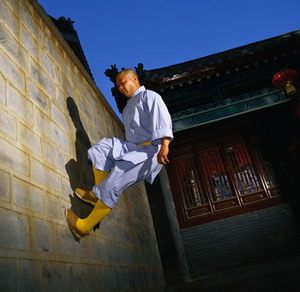|

The training chambers of Shaolin Temple have assumed a nearly mythical status among martial artists, probably because of the legendary results of their successful students. In reality, the chambers were simply training areas for different aspects of kung fu. Some were style-specific, that is, where you would learn the kuen (formwork) of tiger or dragon. Others were places for muscular development, such as horse-training and water-carrying chambers.
Some taught coordination and reflex drills; combat and sparring; weapons use; and meditation and visualization techniques. The actual number of chambers varied, depending upon which temple you were in, the combination of skills taught as a "core" by particular training masters, and, naturally, the size of the temple. You might study a crane form in chamber 4 at 8 a.m., practice sparring there at 12, and return for coordination drills at 5.
When Bodhidharma arrived at the temple, he was refused admittance, probably being thought of as an upstart or foreign meddler by the head abbot (Fang Chang). Rejected by the monks, Bodhidharma went to a nearby cave and meditated until the monks recognized his religious prowess and admitted him. Legend has it that he bored a hole through one side of the cave with his constant gaze; in fact, the accomplishment that earned his recognition is lost to history.
When Bodhidharma joined the monks, he observed that they were not in good physical condition. Most of their routine paralleled that of the Irish monks of the Middle Ages, who spent hours each day hunched over tables where they transcribed handwritten texts. Consequently, the Shaolin monks lacked the physical and mental stamina needed to perform even the most basic of Buddhist meditation practices.
Bodhidharma countered this weakness by teaching them moving exercises, designed to both enhance chi flow and build strength. These sets, modified from Indian yogas (mainly hatha, and raja) were based on the movements of the 18 main animals in Indo-Chinese iconography (e.g., tiger, deer, leopard, cobra, snake, dragon, etc.), were the beginnings of Shaolin Kung Fu.
It is hard to say just when the exercises became "martial arts". The Shaolin temple was in a secluded area where bandits would have traveled and wild animals were an occasional problem, so the martial side of the temple probably started out to fulfill self-defense needs. After a while, these movements were codified into a system of self-defense.
As time went on, this Buddhist sect became more and more distinct because of the martial arts being studied. This is not to say that Bodhidharma "invented" martial arts. Martial arts had existed in China for centuries. But within confines of the temple, it was possible to develop and codify these martial arts into the new and different styles that would become distinctly Shaolin.
One of the problems faced by many western historians is the supposed contraindication of Buddhist principles of non-violence coupled with Shaolin's legendary martial skills.
In fact, the Shaolin practitioner is never an attacker, nor does he or she dispatch the most devastating defenses in any situation. Rather, the study of kung fu leads to better understanding of violence, and consequently how to avoid conflict. Failing that, a Buddhist who refuses to accept an offering of violence (i.e., and attack) merely returns it to the sender. Initially, the kung fu expert may choose to parry an attack, but if an assailant is both skilled and determined to cause harm, a more definitive and concluding solution may be required, from a joint-lock hold to a knockout, to death. The more sophisticated and violent an assault, the more devastating the return of the attack to the attacker. Buddhists are not, therefore, hurting anyone; they merely refuse delivery of intended harm.
Life in Shaolin Temple
Day One Day Two
 China Tours inclusive of visiting the Shaolin Temple, Mount Songshan China Tours inclusive of visiting the Shaolin Temple, Mount Songshan
|
|